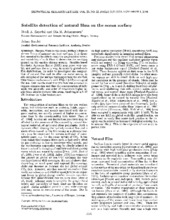| dc.contributor.author | Espedal, Heidi A. | eng |
| dc.contributor.author | Johannessen, Ola M. | eng |
| dc.contributor.author | Knulst, Johan | eng |
| dc.date.accessioned | 2005-10-04T07:44:44Z | |
| dc.date.available | 2005-10-04T07:44:44Z | |
| dc.date.issued | 1996-11-01 | eng |
| dc.Published | Geophysical Research Letters 23(22): 3151-3154 | |
| dc.identifier.issn | 0094-8276 | |
| dc.identifier.uri | https://hdl.handle.net/1956/821 | |
| dc.description.abstract | Natural films on the ocean surface influence air-sea fluxes of momentum, heat, and gas. It is therefore essential to be able to map the geographical extent and variability of such films to determine the resulting impact on the earth’s climate system. Satellite based Synthetic Aperture Radar (SAR) may prove very useful, and perhaps the only way, to quantify global scale film distribution. In order to investigate the composition of natural film and its effect on radar return, in situ samples of the surface microlayer were for the first time taken simultaneously with ERS-1 SAR coverage of the sea. Our results show that the film was enriched in organic composition and that the concentration of fatty acids was generally one order of magnitude higher inside than outside natural film areas, resulting in a 6–17 dB decrease in radar backscatter. | en_US |
| dc.format.extent | 14817421 bytes | eng |
| dc.format.mimetype | application/pdf | eng |
| dc.language.iso | eng | eng |
| dc.publisher | American Geophysical Union | eng |
| dc.subject | Global change | eng |
| dc.subject | Remote sensing | eng |
| dc.subject | Oceanography | eng |
| dc.title | Satellite detection of natural films on the ocean surface | eng |
| dc.type | Journal article | eng |
| dc.type | Peer reviewed | eng |
| dc.description.version | publishedVersion | |
| dc.rights.holder | Copyright 1996 by the American Geophysical Union | |
| dc.identifier.doi | https://doi.org/10.1029/96gl03009 | |
| dc.source.journal | Geophysical Research Letters | |
| dc.source.40 | 23 | |
| dc.source.14 | 22 | |
| dc.source.pagenumber | 3151-3154 | |
